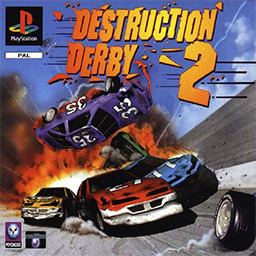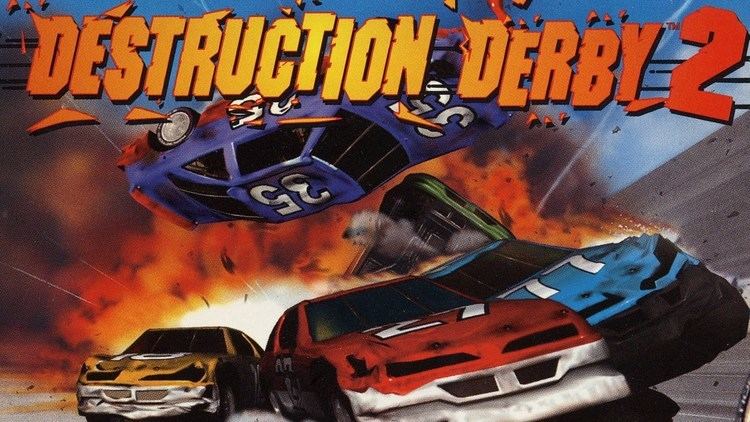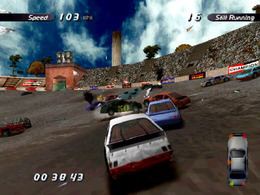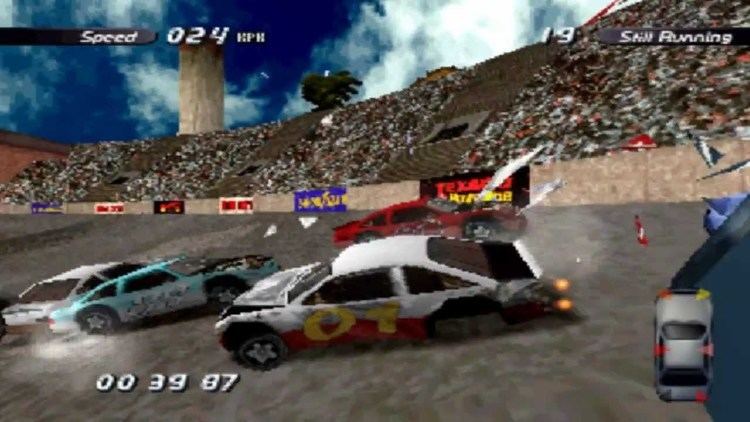9.6 /10 1 Votes
4.7/5 Emuparadise | 4.8/5 CoolROM Initial release date 1996 Developer Ubisoft Reflections | |||||||||||||||||||||||||||||||||
 | ||||||||||||||||||||||||||||||||||
Release date(s) Microsoft WindowsEU: 1996NA: 31 October 1996PlayStationNA: 31 October 1996EU: 13 January 1997JP: 21 February 1997 Genre(s) Vehicular combat, racing Similar Psygnosis games, Racing video games | ||||||||||||||||||||||||||||||||||
Classic game room destruction derby 2 review for playstation
Destruction Derby 2 is a vehicular combat racing video game developed by Reflections Interactive and published in 1996 by Psygnosis for Microsoft Windows and PlayStation. The sequel to Destruction Derby, players race with the goal of earning points by damaging opponent cars. Standard races and matches based in arenas with the goal of remaining the last player driving are also available. The game is an overhaul of the original, and features ideas that did not make it into the first game: the tracks feature obstacles and improved realism, and the car mechanics were redesigned. Development was also focused on Americanisation: the game style shifted away from the British banger racing of the original, and the cars and music were changed to fit. The game features Paul Page as commentator, and the soundtrack was created by thrash metal bands Jug and Tuscan. Reception was mixed: some reviewers praised the gameplay and car physics, but the difficulty was widely criticised. The third instalment in the Destruction Derby series, Destruction Derby Raw, was released in 2000.
Contents
- Classic game room destruction derby 2 review for playstation
- Destruction derby 2 longplay
- Gameplay
- Development
- Reception
- References

Destruction derby 2 longplay
Gameplay

Destruction Derby 2 is the sequel to Destruction Derby. Like the original, players race on up to seven circuits, in a range of modes. The modes are: Wrecking Racing (in which, although a race, the goal is to earn points by destroying or spinning the other competitors), Stock Car (a typical race, although cars can still be damaged or destroyed) and Destruction Derby, based around the crash arenas instead of race tracks, in which the goal is to inflict as much damage as possible. In the race tracks, a new feature is the pit stop, where cars can be repaired. Another major difference is that tracks feature obstacles such as jumps and crossovers. Destruction Derby 2 supports Namco's NeGcon controller, and players can quit a race at any time.

There are also different game types: Championship, Race Practice, Time Trial, and Multi Player. Championship is where players compete in a league of seasons consisting of four races and, in Wrecking Racing, a Destruction Derby match. Race Practice is where players practise a race, and Time Trials is a race against the clock. Multi Player allows up to nine players to race individually. After all have finished, a league table showing their placings is displayed.
Development

As the original Destruction Derby was developed in seven months, the game suffered from design flaws and there were ideas that could not be implemented in time. According to producer Martin Edmondson, Destruction Derby 2 is a rewrite of the original, with only the 2D collision algorithms remaining intact. The engine was rewritten to handle the larger tracks (with obstacles such as hills and jumps), and the car dynamics redesigned. The collision routines were extended so cars can handle being flipped over. The development team were more familiar with the PlayStation's hardware, and Edmondson stated that Destruction Derby 2 felt like a new game rather than merely a sequel with more tracks.
Edmondosn wanted to Americanise the game as the original had a British banger racing feel. The design and visuals were also Americanised: the cars were made to resemble NASCARs, and all the tracks are set in the United States. The music was also Americanised: wanting it to match the American Stock Racing, Edmondson visited races across the United States, and noticed that they featured metal music. Thrash metal bands Jug and Tuscan were chosen to compose the soundtrack, as some members of the team were involved with them. Because of the soundtrack (soft-spoken commentary did not fit), Commentator Paul Page performed as the announcer: Edmondson went to the United States and asked him to give a commentary at a studio in Indianapolis. His style proved to be what Edmondson was looking for.
The tracks had more realism than the original, with visuals such as forests, Neon Cities, and Canyons, complete with appropriate obstacles. The team travelled to photograph the textures. The tracks were constructed in Softimage 3D, and converted to PlayStation format mesh data using a custom tool, and a program to texture the meshes with the PlayStation's controller was written. The team were inspired by Daytona's revolving windmills, and large jumps were implemented to add drama to the tracks. The most realistic aspect of the race tracks was the pit stop, although Edmondson stated that he limited players to one stop because the team did not want to detract from the action, and because a penalty system would have added a lot of extra work. Cars nearing destruction were made to be realistic and unpredicatable, with effects such as missing the bonnet (hood) and being on fire.
Wrecking Racing was meant to enable a broad range of strategies. This was hard to balance, but it proved to be possible to win with every such strategy. Edmondosn came up with Stock Car Racing: he was watching the Bnager World Finals at Arena Essex, and he noticed that there were some cars simply racing rather than trying to destroy each other. The normal race mode was implemented because the team had an engine that was capable of running a normal racing game. For Destruction Derby mode, more varied arenas were implemented to take advantage of a new physics system developed by Reflections. Edmondson decided against implementing features such as speed boosts and collectibles because he did not want the game to feel like an arcade game, and wanted the car physics to be as realistic as possible. Destruction Derby 2 was released on the PlayStation in 1996, and a PC version soon followed. The next instalment in the Destruction Derby series, Destruction Derby Raw, was released in 2000.
Reception
The PlayStation version received positive reviews. Edge praised the improved damage system as a result of the new physical modelling routines, saying the crashes are much more intense than the original. The 3D engine was described as "impressive", but the lack of a link-up multiplayer mode was criticised. Ed Lomag of Computer and Video Games lauded the improved car mechanics and track design, and also liked the UK PAL version being in full screen and runs at a full frame rate, citing it as why it is possible to develop good British PlayStation games. Despite these, he criticised the limited re-playability. The Electric Playground commented that due to the cars' look, they can perform many manoeuvres even in the presence of others. The scenery and damage effects were complimented, and the game was described as a hybrid of Ridge Racer Revolution, The Need for Speed, and Die Hard Trilogy. Game Revolution described the Stock Car Racing as "almost perfect", and the tracks as "extremely cool", but criticised the steering sensitivity. Absolute PlayStation described the game as a "vast improvement" over the original, but said the gameplay is identical and "rather shallow". IGN believed that the game compensates too much for the lack of difficulty of the first game: they criticised the artificial intelligence for being aggressive and commented that it is "impossible" to catch up with the other cars. Despite this, they praised the car physics and graphics. Jeuxvideo.com praised the playability, saying it forces the player to concentrate, and the soundtrack, saying it integrates well with the game's atmosphere, but criticised the commentary as "repetitive". Gamezilla's Mark Skorupa described the graphics as "top notch", but also said that it breaks what was good in the original game.
The PC version did not fare as well. Rick Broida of Computer Gaming World criticised the lack of multiplayer, the high system requirements, and the difficulty. Despite these criticisms, he complimented the improved (over the original) graphics and tracks. Sean Anderson of Gamezilla criticised the way the game handles multiplayer, and described the commentator as "annoying". Frederick Claude of Coming Soon Magazine compared the PC version to the PlayStation version, and said the PC version supports multiplayer over DirectPlay, which he believed to be an improvement over the PlayStation version's multiplayer. For the graphics, he described the PlayStation version as "far more beautiful" than the PC version, and criticised the SVGA graphics mode for its high system requirements. Tim Soete of GameSpot described the PC version's graphics as an improvement over those of the original, but not as good as the PlayStation version, and criticised the cars for being "impossible" to overtake. Craig Majaski of Gamer's Zone complimented the sound and music, describing them as "top-notch", but criticised the difficulty, saying the computer cars are "almost impossible" to beat. He described Destruction Derby 2 as "an average game that could have been an excellent title".
